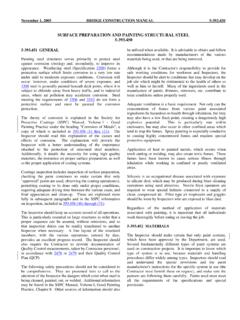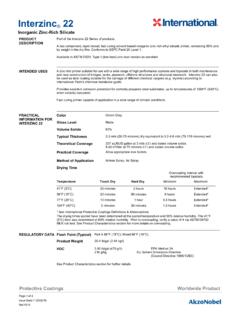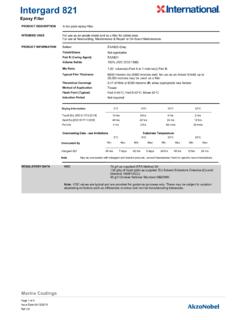Transcription of SSPC-SP1 Solvent Cleaning
1 SSPC-SP1 Solvent Cleaning The method of Solvent Cleaning is intended to remove all visible oil, grease, soil, drawing and cutting compounds, and all other soluble contaminants from steel surfaces. The specification calls for the removal of dust before Solvent Cleaning by the use of a stiff bristle brush. After Solvent Cleaning , dust is to be removed by either blowing off with clean dry air or vacuum Cleaning . The specification lists several different ways in which Solvent cleaner may be applied to the surface including wiping or scrubbing the surface with Solvent , spraying Solvent directly onto the surface, vapor degreasing, immersion, alkaline cleaners, and steam Cleaning . sspc -SP2 Hand Tool Cleaning This standard covers the removal of loose mill scale, loose rust, loose paint, and other loose detrimental foreign matter from surfaces with the use of non-powered hand tools.
2 Adherent products as determined by a dull putty knife are not to be removed with this procedure. SSPC-SP1 removes oil and grease before Cleaning with hand tools, and compressed air or a vacuum will remove dust after this Cleaning procedure is completed. Removing all weld slag and stratified rust with impact tools, using non-impact methods such as scraping to remove all non-adherent materials, and feathering an adherent paint coating, are all hand tool Cleaning methods accepted by this standard. sspc -SP 3 Power Tool Cleaning sspc -SP3 details the use of power-assisted tools for surface preparation. The preparation method described here is intended to remove the same contaminants from a surface as in sspc -SP2, and the procedures before and after using this Cleaning method are identical to sspc -SP2.
3 The standard includes using rotary, impact, or power brushing tools to remove stratified rust, weld slag, and mill scale. Power abrading tools also acceptably remove mill scale according to the standard. sspc -SP3 requires power tools to be used in a manner that prevents the formation of burrs, sharp ridges, and sharp cuts. Feathering the edges of adhered paint surfaces is also required. sspc -SP5 / NACE 1 White Metal Blast Clean A white metal blast will remove all coatings, mill scale, rust, oxides, corrosion products, and all other foreign products from a steel surface. sspc -SP5 provides conditions for the end condition of a white metal blast, and the materials and procedure necessary for providing the end condition. The standard lists dry abrasive blasting as the preferred method with wet blasting an option to be agreed upon between the two parties.
4 The size and type of abrasive media to be used depends on the profile specified by the coating system to be used. The standard then requires oil, grease, and dust to be removed from the surface and the work inspected. sspc -SP7 / NACE 4 Brush Off Blast Clean This standard states a brush of blast clean will allow as much of an existing adherent coating to remain as possible and to roughen it s surface prior to coating application. This blasting method cleans less aggressively than an industrial blast clean. A provided definition of a brush-off blast cleaned surface describes a surface free of all visible oil, grease, dirt, dust, loose mill scale, loose rust, and loose coating when viewed without magnification. The surface may still include profiled and tightly adherent mill scale, rust, and coating.
5 sspc -SP10 / NACE 2 Near-White Metal Blast Cleaning Near-White Metal Blast Cleaning provides a greater degree of Cleaning than commercial blast Cleaning , but less than white metal blast Cleaning . The sspc -SP10 s definition of a near-white metal blast clean requires the surface to be free of all visible oil, grease, dust, dirt, mill scale, rust, coating, oxides, corrosion products, and other foreign matter when viewed without magnification. The standard also provides requirements for random staining on the surface which shall not exceed five percent of each unit area of surface. The surface shall be cleaned of oil, grease, and dust after the near-white metal blasting procedure. sspc -SP11 Power-Tool Cleaning to Bare Metal This surface preparation standard is similar to that some less aggressive blast cleans.
6 The standard requires the surface to be free from all visible oil, grease, dirt, dust, rust, coating, oxides, mill scale, corrosion products, and other foreign matter when viewed without magnification. However, some rust remaining at the bottom of pits is acceptable if the surface was pitted to begin with. A surface profile of no less than one mill between peaks and valleys is required. Grinding tools and impact tools are both acceptable means for achieving the level of Cleaning specified. Oil, grease, and dust must be removed both before and after the Cleaning procedure. sspc -SP12 / NACE 5 Surface Preparation and Cleaning of Metals by Water jetting Prior to Recoating Water jetting is the use of standard jetting from a nozzle at high pressures (10,000 psi or higher) to prepare a surface for coating.
7 Intended primarily for carbon steel, but applicable on other metals, water jetting does not create a profile on the metal substrate. However, metals with an existing profile acceptable for painting can be cleaned with water jetting to expose the existing profile. Water jetting will remove all loose rust, loose mill scale, and loose coatings uniformly while meeting the conditions of WJ-1, WJ-2, WJ-3, and WJ-4. sspc -SP13 / NACE 6 Surface Preparation of Concrete Provides requirements for surface preparation of concrete by mechanical, chemical, or thermal methods prior to the application of bonded protective coating or lining systems. sspc -SP14 / NACE 8 Industrial Blast Cleaning Removal of all visible oil, grease, dust and dirt, when viewed without magnification.
8 Traces of tightly adherent mil scale, rust, and coating residues are permitted to remain on 10% of each unit area of the surface if they are evenly distributed. Shadows, streaks, and discoloration caused by stains of rust, stains of mill scale, and stains of previously applied coating may be present on the remainder of the surface. sspc -SP16 Brush-Off Blast Cleaning of Coated and Uncoated Galvanized Steel, Stainless Steels, and Non-Ferrous Metals Use of this surface preparation standard roughens and cleans the bare substrate including hot-dip galvanized to create a profile suitable for painting. Completion of this process produces a profiled surface free of all visible oil, grease, dirt, dust, metal oxides (corrosion products), and other foreign matter when viewed without magnification.
9 The standard also contains unique procedures for use on galvanized steel including inspection for a passivation treatment and wet storage stain.





